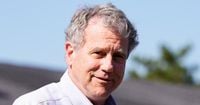In a move set to shake up Ohio politics and reverberate across the national landscape, former Senator Sherrod Brown has decided to launch a comeback bid for the U.S. Senate in 2026, according to multiple reports published on August 12, 2025. Brown, who served three terms in the Senate before narrowly losing his seat to Republican Bernie Moreno in 2024, will challenge current Senator Jon Husted, the Republican incumbent appointed earlier this year to replace JD Vance after Vance ascended to the vice presidency.
Brown’s decision, first reported by Cleveland.com and confirmed by Politico, Axios, and The New York Times, comes after months of speculation about his political future. At 72, Brown remains one of Ohio’s most prominent Democrats, with a career in public service stretching back to 1974 when he became the youngest person ever elected to the Ohio Statehouse. Over the decades, he’s served as Ohio’s secretary of state, a congressman, and, for 18 years, a U.S. senator.
The upcoming special election will determine who completes the remainder of Vance’s term, with the winner facing voters again in 2028 for a full six-year term. For Democrats, Brown’s candidacy offers a glimmer of hope in a state that has trended Republican in recent cycles. As NBC News points out, Brown was the only Democrat to win statewide office in Ohio over the past decade, and his ability to outperform his party in a state that Donald Trump carried by 11 points in 2024 is seen as a key asset.
Brown’s return to the political stage follows a period of reflection and nonprofit work. After his 2024 defeat—where he lost by about 3.5 percentage points in what The New York Times called the most expensive Senate race in the nation, with over $451 million spent—Brown launched the Dignity of Work Institute, aimed at reconnecting the Democratic Party with working-class voters. In an essay published earlier this year, Brown described this mission as both "an electoral and a moral imperative."
His decision to seek the Senate seat, rather than run for governor against presumptive GOP nominee Vivek Ramaswamy, has already clarified the Democratic field for 2026. Dr. Amy Acton, former Ohio Department of Health director and Brown ally, remains the only Democrat officially in the gubernatorial race, though former Congressman Tim Ryan is reportedly mulling a bid. "Sherrod Brown's decision to run for the U.S. Senate has renewed and heightened Tim Ryan's interest in running for governor to further serve the people of Ohio," Ryan’s spokesperson Dennis Willard told USA Today.
Brown’s influence within the party is undeniable. As Cincinnati Mayor Aftab Pureval told NBC News, "I think Sen. Brown is still our best advocate and still our best messenger for the Democratic agenda. His deep and genuine roots in the labor movement and his exceptional record while in office speak for themselves. But now is the time for genuine leadership in Ohio, and I believe Sen. Brown is the person to demonstrate that."
For Republicans, the prospect of a Brown comeback is less than welcome. Tyson Shepard, a spokesperson for Husted’s campaign, told NBC News, "Should Brown enter the race as Schumer’s handpicked candidate, he will be starting in the biggest hole of his political career. He has never faced a candidate like Jon Husted. Brown’s slogans will ring hollow as his coalition walks away, tired of the radical policies he’s forced to support to appease his coastal bosses in California and New York." Nick Puglia, a regional press secretary for the Republicans’ Senate campaign arm, echoed the sentiment, stating, "Ohioans just rejected Sherrod Brown and they’ll do it again in 2026," as reported by Nexstar Media.
Strategically, the stakes are high. The Cook Political Report currently rates the Ohio Senate seat as "likely Republican," a slight shift from its previously solid GOP status. Republicans hold a 53-47 majority in the Senate, with Vance serving as the tiebreaker. For Democrats to retake control, they must flip at least four seats, making Ohio one of several critical battlegrounds alongside North Carolina, Maine, and Iowa.
Brown’s campaign, still in its early stages, is already drawing national attention. Senate Minority Leader Chuck Schumer (D-N.Y.) has reportedly traveled to Ohio twice in recent months to recruit Brown, with Axios noting that Schumer had also met with Brown in Chicago last month. According to The New York Times, Schumer has made recruiting top-tier candidates a focus after Democrats managed to limit their Senate losses in 2024, despite Trump’s victory in the presidential race.
As the Republican-aligned group Standing Tall Action prepares to launch a digital ad campaign praising Husted’s support for Trump-aligned policies, the outlines of the 2026 contest are coming into focus. Husted, a former lieutenant governor, has backed a budget bill slashing $1 trillion from Medicaid, eliminating taxes on tips, increasing the child tax credit, and enacting tax cuts that primarily benefit high earners, according to USA Today. His reliable alignment with Trump’s agenda is expected to be a central theme of his campaign.
For Brown, the challenge will be to rebuild a winning coalition in a state where Republicans control every statewide executive office and where the Democratic brand has struggled. As he told NBC News late last year, "I’m not going to whine about my loss. But I lost in large part because the national reputation of the Democratic Party is that we are sort of a lighter version of a corporation—a corporate party. We’re seen as a bicoastal, elite party. And it’s hard to argue that." Reflecting on policy battles, he added, "We couldn’t pass the minimum wage because Republicans almost uniformly were against it. It’s always Republicans who are on the wrong side, and there aren’t enough Democrats on the right side to win. … It’s a good example of how workers get screwed."
Despite the uphill battle, Democrats see Brown’s candidacy as their best shot at breaking the GOP’s hold on Ohio. In the 2024 election cycle, Brown received 117,250 more votes than then-Vice President Kamala Harris, suggesting a personal appeal that transcends broader party trends. As Ohio prepares for another high-stakes, high-dollar Senate race, all eyes will be on whether Brown can once again defy the odds and reclaim his seat.
With a crowded field, shifting political winds, and national attention focused on the Buckeye State, the stage is set for a contest that could determine the balance of power in the U.S. Senate—and the direction of the Democratic Party in the Midwest for years to come.


